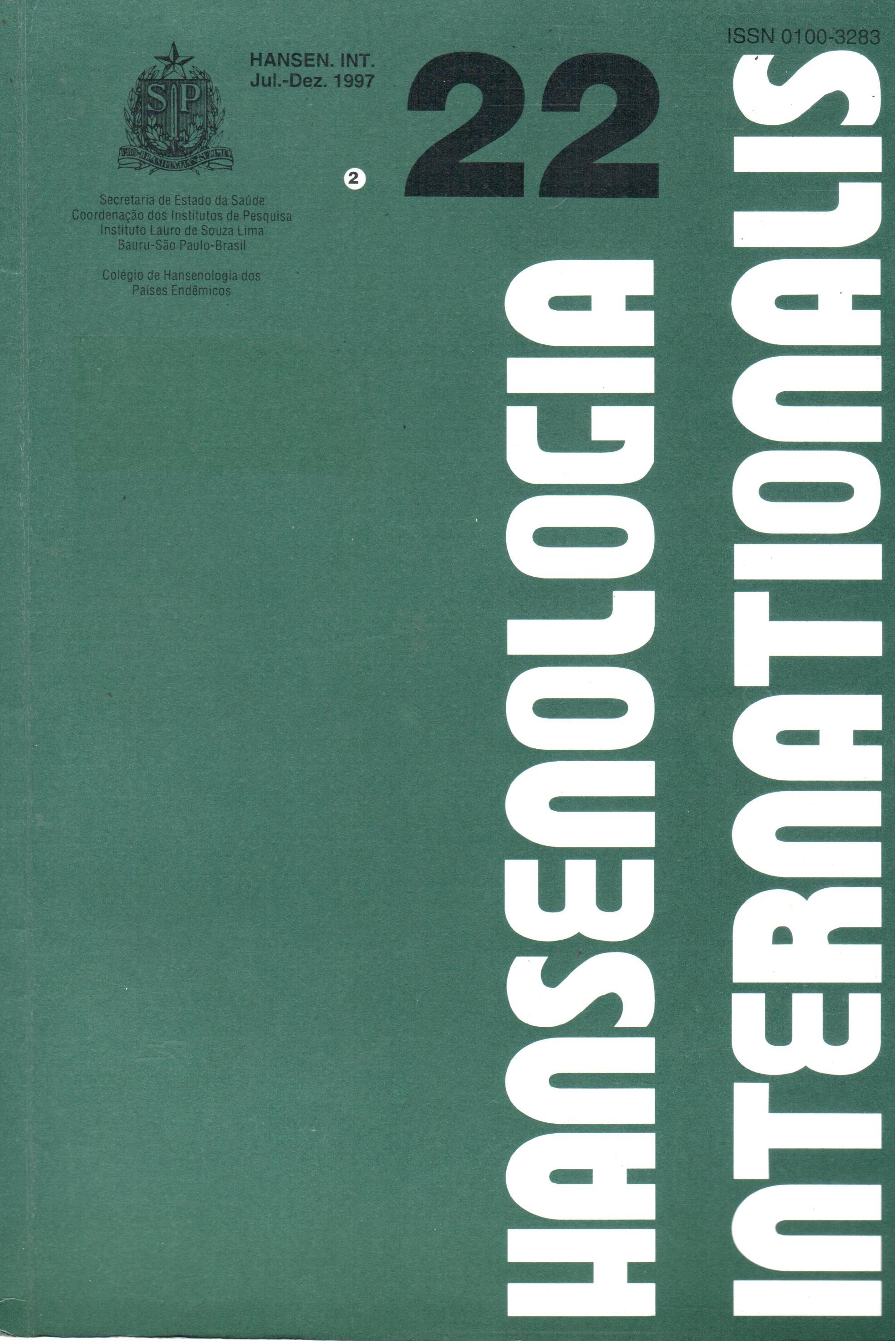Resumo
Os poucos estudos já publicados sobre a determinação de fenótipo secretor dos antígenos ABH na saliva de hansenianos têm demonstrado não haver uma correlação significativa entre estas substâncias e a suscetibilidade à doença. No presente estudo avaliamos 74 pacientes, sendo 27 virchovianos, 23 tuberculóides e 24 dimorfos, quanto à presença de antígenos ABH nos eritrócitos e na saliva, pela reação de aglutinação em tubo e inibição de aglutinação. A freqüência dos grupos sangüíneos ABO e do fenótipo secretor e não secretor nestes pacientes e no grupo controle foram: 0= 40,5%(49%); A= 41,9%(36,5%); B= 10,8%(10,9%); AB= 6,8%(3,6%); secretor= 68,9%(82,5%) e não secretor= 31,1%0 7,5%). Analisando-se os resultados apresentados nos hansenianos, observamos que não houve diferença significativa dos encontrados no grupo controle, com relação à distribuição dos antígenos ABH pesquisados nos eritrócitos e na saliva.
Referências
2.ARNEBERG, P., KORNSTAD, L., NORDBO, H., GJERINO, P. Less dental caries among secretors than among non-secretors of blood group sbstance.
Scand. J. Dent. Res., v.84, p.362-366, 1976.
3.BEIGUELMAN B. Sistema ABO e epidemiologia de lepra. Rev. Paul. Med., v.65, p.80-86, 1964.
4.BETH VINCENT. Técnicas aplicadas à imunohematologia eritrocitária. In. Alves de Lima, L., Callado,M. R. L., Santos, J. A. Curso de Imunohematologia.
Botucatu. Faculdade de Medicina, p. 122, 1992.
5.BRATTHALL, D., CARLEN, A. apud LIGTENBERG, A.J.M., VEERMAN, E.C.I., GRAAFF DE J., NIEUW AMERONGEN, A.V. Influence of the blood group reactive substances in saliva on the aggregation of Streptococcus rattus. Antonie van Leeuwenhoek, v.57, p.97-107, 1990.
6.CAMPS, F.E.,DODD BARBARA E., LINCOLN, P. J. Frequencies of secretors and non-secretors of ABH group substances among 1.000 alcoholic patients. Brit. Med. J., v.4, p.457-459, 1969.
7.CHEHL, S. K., JOB, C. K., HASTINGS, R. C. Transmission of leprosy in nude (nu/nu) nice using various portals of entry. XII International leprosy Congress Proceedings, New Delhi, p.522-524, 1984.
8.CLARKE C. A., EVANS D. A. P., McCONNELL R. B., SHEPPARD P. M. Secretion of blood group antigens and peptic ulcer. Brit. Med. í.,p.603-607, 1959.
9.CONGRESSO NACIONAL DE LEPROLOGIA 6º, Madrid, 1953. Memória. Madrid, Association International de lepra, 1953. 1344p.
10.CREE, I. A, SMITH, W.C.S., BECK, J.5. Serum antibody responses to mycobacteria in leprosy patients and their contacts. Leprosy Review, v.59, p.317-327, 1988.
11.DAVEY, T. F., REES, R.J.W. The nasal discharge in leprosy. Clinical and bacteriological aspects. Leprosy Review, v.45, p.121-134, 1974.
12.DOUGLAS, C.W.I. The binding of human salivary - amylase by oral strains of streptococcal bacteria. Arch. Oral Biol., v.28, p.567-573, 1983.
13.DUDLEY, J.P. Adherence of microorganisms in infections of the respiratory tract. Laryngoscope, v.92, p.68-69, 1982.
14.DUNSFORD I., BOWLEY C.C. apud SALDANHA, S.G. ABO blood groups and salivary secretion of ABH substances among three racial groups in São Paulo. Rev. Brasil. Genet., v.1, p.175-186, 1982.
15.ERCSON, T.H., PRUITT, K., WEDEL, H. The reaction of salivary substances with bacteria. J. Oral Patol., v.4, p.307-323, 1975.
16.GIBBONS, R.J., ETHERDEN, I. Comparative hydrophobicities of oral bacteria and theiradherence to salivary pellicles. Infect. Immun., v.41, p.1190- 1196, 1983.
17.GIBBONS, R.J., QURESHI, J.V. Selective binding of blood group-reactive salivary mucins by Streptococcus mutans and other oral organisms. Infect. Immun., v.22, p.665-671, 1978.
18.GLYNN, L. E., HOLBOROW E. J. Blood groups and their secretion in rheumatic fever. Rheumatology, v.2, p.113-130, 1969.
19. J A C O B S ON , S . H . , L OMB E R G , H . Overrepresentation of blood group non-secretors in adults with renal scarring. Scand. I. Urol . Nephrol.. v.24, p.145-150, 1990.
20. KALLENIUS, G., SVENSON, S.B., MÖLLBY, R., CEDERGREN, B., HULTBERG, H., WINBERG, J. Structure of carbohidrate part of receptor on human uroepithelial cells for pyelone- phritogenic Escherichia colt. Lancet. p.604-606, 1981.
21.MANDEL, I.D., In defence of the oral cavity. pp 4 7 3 - 4 9 1 In : KLEINBERG I , El l i s o n A.S. , MANDEL I.D. Saliva and dental caries (a special
supplemment to Microbiology Abstracts). Information Retrieval. Inc, Washington DC. 1979.
22. MARCUS D.M. The ABO and Lewis blood-group system. Immunochemistry, genetics and relation to human disease. N. Engl. J. Med., v.280, p.994-
1006, 1969.
23 .MOURANT , A . E . , KOP EC , A .C. & DOMA - MIEWSKA-SOBEZA, K. The blood groups and other polymorphic systems. Oxford University Press, 1978.
24.POLLOCK apud LIGTEMBERG, A.J.M., VEERMAN, E.C.I., GRAAFF, J. NIEUW AMERONGEN, A.V. Influence of the blood group reactive substances
in saliva on the aggregation of Streptococcus rattus. Antonie van Leeuwenhoek, v.57, p.97107, 1990.
25.SALDANHA, S.G. ABO blood groups and salivary secretion of ABH substances among three racial groups in São Paulo city. Rev. Brasil. Genet.,v.1, p.175-186, 1982.
26.SEHGAL, V.N. DUBE, B. Secretion of blood groupspecific substances in the saliva of leprosy patients. Int. J. Leprosy, v.35, p.375-376, 1967.
27.SPICKET, S.G. Genetics and the epidemiology of leprosy. I. The incidence of leprosy. Leprosy Review, v.33, p.76-93, 1962
28.WEINER, A.S. Blood groups and disease. Lancet., p.813-816, 1962.
29.WILLIAMS, R.C., GIBBONS, R.J. Inhibition of streptococcal attachment on human buccal epithelial cells by antigenically similar salivary glycoproteins. Infect. Immun., v.11, p.711-718, 1975.

Este trabalho está licenciado sob uma licença Creative Commons Attribution 4.0 International License.
